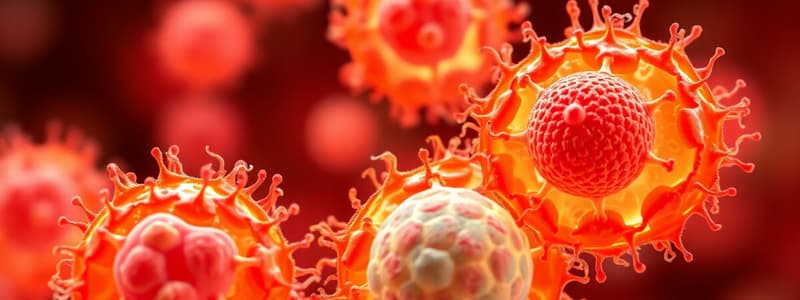Podcast
Questions and Answers
Cells are the basic unit of life.
Cells are the basic unit of life.
True (A)
Which of the following are types of cells?
Which of the following are types of cells?
- Multicellular
- Single-celled
- Prokaryotic (correct)
- Eukaryotic (correct)
What is the main characteristic of prokaryotic cells?
What is the main characteristic of prokaryotic cells?
They have no nucleus.
What is an organelle?
What is an organelle?
The __________ is the control center of the cell.
The __________ is the control center of the cell.
Which organelle is responsible for the production of ATP?
Which organelle is responsible for the production of ATP?
What is the function of the Golgi apparatus?
What is the function of the Golgi apparatus?
Chloroplasts are responsible for cellular respiration.
Chloroplasts are responsible for cellular respiration.
Match the following organelles with their functions:
Match the following organelles with their functions:
What do vacuoles do?
What do vacuoles do?
Flashcards are hidden until you start studying
Study Notes
Cells are the Basic Unit of Life
- Cells are the fundamental building blocks of all living organisms, whether single-celled (unicellular) or multicellular.
- They are responsible for carrying out all the essential life processes.
Types of Cells
-
Prokaryotic cells: Lack a membrane-bound nucleus and other internal organelles.
- Examples include bacteria and archaea.
- Are the simplest and most ancient forms of life on Earth.
- Some prokaryotes, like cyanobacteria, are capable of photosynthesis.
- Many prokaryotes thrive in extreme environments, making them extremophiles.
-
Eukaryotic cells: Possess a true nucleus containing their genetic material (DNA) and other membrane-bound organelles.
- Include both single-celled organisms (like protists) and multicellular organisms (like plants, animals, and fungi).
- Evolved later than prokaryotic cells, approximately 1.7 to 1.9 billion years ago.
Major Parts of a Cell
- Nucleus: The control center of the cell.
- Contains DNA, which carries the genetic instructions for the cell.
- Regulates gene expression, directing the synthesis of proteins.
- Cell Membrane: A thin, double-layered barrier that surrounds the cell.
- Controls the movement of substances in and out of the cell, maintaining its internal environment.
- Cytoplasm: The fluid that fills the cell, located between the cell membrane and the nucleus.
- Serves as the site for numerous metabolic reactions.
- Provides structural support to the cell.
Organelles: The "Little Organs" of the Cell
- Organelles are specialized structures within a cell that perform specific functions.
- They contribute to the overall functioning of the cell.
Membrane-Bound Organelles
-
Nucleus: The largest organelle in the cell.
- Contains chromosomes, which are thread-like structures made up of DNA and proteins.
- Responsible for cell growth, reproduction, and protein synthesis.
-
Nucleolus: A smaller structure within the nucleus.
- Composed of RNA and proteins.
- Responsible for the production and assembly of ribosomes.
-
Nuclear Membrane: A double-layered membrane that encloses the nucleus.
- Separates the chromosomes from the cytoplasm.
- Provides structural support to the nucleus.
-
Endoplasmic Reticulum (ER): An extensive network of interconnected membranes in the cytoplasm.
- Smooth ER: Composed of tubules and lacks ribosomes.
- Involved in the synthesis and storage of lipids and steroids.
- Rough ER: Covered with ribosomes.
- Involved in protein synthesis.
- Smooth ER: Composed of tubules and lacks ribosomes.
-
Golgi Apparatus: A stack of flattened sacs found in both plant and animal cells.
- Responsible for processing, modifying, and packaging proteins and lipids that are received from the ER.
- Involved in transporting these molecules to other parts of the cell or to the cell's exterior.
-
Lysosomes: Spherical sacs containing digestive enzymes.
- Break down biomolecules, including carbohydrates, lipids, proteins, and nucleic acids.
- Involved in recycling food particles and destroying invading bacteria.
-
Mitochondria: Known as the "powerhouse of the cell."
- Responsible for aerobic respiration, a process that produces energy in the form of adenosine triphosphate (ATP).
- Essential for providing the energy required for cellular processes.
-
Chloroplasts: Found in plant cells.
- Site of photosynthesis, the process by which plants convert light energy into chemical energy (sugars).
-
Vacuoles: Storage structures that store water, nutrients, and waste products.
- Larger in plant cells than in animal cells.
- Play a role in maintaining cell turgor pressure, keeping cells rigid.
-
Peroxisomes: Organelles containing enzymes that oxidize organic substances like fats.
- Break down toxic materials and use oxygen to break down molecules.
Non-Membrane-Bound Organelles
-
Cell Wall: A rigid outer layer found in plant cells.
- Provides structural support and protection to the cell.
- Maintains cell shape and prevents the cell from bursting due to high internal pressure.
-
Centrioles: Organizing centers for microtubules, found in animal cells.
- Important for cell division (mitosis and meiosis).
- Form spindle fibers during cell division, which attach to chromosomes and help move them apart.
-
Ribosomes: Small organelles composed of RNA and proteins.
- Found in both plant and animal cells.
- Involved in protein synthesis, translating genetic information from mRNA into amino acid chains, which then fold into functional proteins.
Studying That Suits You
Use AI to generate personalized quizzes and flashcards to suit your learning preferences.




